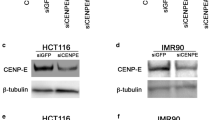Abstract
Colchicine induces the formation of small nuclei called micronuclei which contain limited parts of the genome. Some of them exhibit a DNA content equivalent to that of a single chromosome. Our purpose was to study the preservation of chromosome integrity during this micronucleation in PtK1 cells. Observation of karyotypes obtained after 3 days of cell cycle restoration revealed that micronucleation did not affect chromosome integrity or the presence of each chromosome pair in the surviving cells. In ‘early restoration’ cells, all the chromosomes included a centromere and were represented in the karyotype, but at variable rates. Furthermore, flow cytometry analysis of micronucleated cells, intermediate in DNA rate between control PtK1 cells in g1 and those in G2/M phases, led us to consider the possibility of selective replication of some chromosomes during micronucleation. Using antibodies against the kinetochore proteins, we derived the presence of one centromeric region (1–2 spots) in the smallest micronuclei. Therefore, these data (karyotypes, number of chromosomes, DNA content and kinetochore proteins) seem to indicate that micronucleation does not induce chromosome damages or translocations. Micronuclei are a convenient tool for investigation of the role of the different chromosomes in the organization of the interphase nuclei.
Similar content being viewed by others
References
Athwal RS, Smarsh M, Searle BM, Deo SS (1985) Integration of a dominant selectable marker into human chromosomes and transfer of marked chromosomes to mouse cells by microcell fusion. Somatic Cell Mol Genet 11:177–187
Bond DJ, Chandley AC (1983) Aneuploidy. Oxford University Press, Oxford
Brenner S, Pepper D, Berns MW, Tan E, Brinkley BR (1981) Kinetochore structure, duplication and distribution in mammalian cells: analysis by human autoantibodies from scleroderma patients. J Cell Biol 91:95–102
Ege T, Ringertz NR, Hamberg H, Sidebottom E (1977) Preparation of microcells. In: Prescott DM (ed) Methods of cell biology, vol 15. Academic, New York, pp 339–357
Fournier REK, Ruddle FH (1977) Microcell-mediated transfer of murine chromosomes into mouse, Chinese hamster and human somatic cells. Proc Natl Acad Sci USA 74:319–323
Ghosh S, Paweletz N (1984a) Synchronous DNA synthesis and mitosis in multinucleate cells with one chromosome in each nucleus. Chromosoma 89:197–200
Ghosh S, Paweletz N (1984b) Nuclear asynchrony in multinucleate rat kangaroo cells. Eur J Cell Biol 35:304–311
Ghosh S, Paweletz N, Ghosh I (1978) Mitotic asynchrony of multinucleate cells in tissue culture. Chromosoma 65:293–300
Giloh H, Sedat JW (1982) Fluorescence microscopy: reduced photobleaching of rhodamine and fluorescein protein conjugates by N-propyl gallate. Science 217:1252–1255
Grégoire M (1984) Troisième cycle. Thesis, Paris VI
Grégoire M, Hernandez-Verdun D, Bouteille M (1984) Visualization of chromatin distribution in living PtO cells by Hoechst 33342 fluorescent staining. Exp Cell Res 152:38–46
Hernandez-Verdun D, Gregoire M, Labidi B, Bouteille M (1986) Sorting of individual interphase chromosomes. Exp Cell Res 164:243–250
Högstedt B, Karlsson A (1985) The size of micronuclei in human lymphocytes varies according to inducing agents used. Mutat Res 156:229–232
Kopnin BP, Massino JS, Gudkov AV (1985) Regular pattern of karyotypic alterations accompanying gene amplification in Djungarian hamster cells: study of colchicine, adriablastin and methotrexate resistance. Chromosoma 92:25–36
Labidi B, Gregoire M, Hernandez-Verdun D, Bouteille M (1985) Procedure for isolating micronuclei from rat kangaroo cultured cells containing individualized chromosomes. Eur J Cell Biol 38:165–170
Labidi B, Grégoire M, Frackowiak S, Hernandez-Verdun D, Bouteille M (1987) RNA polymerase activity in PtK1 micronuclei containing individual chromosomes; an in vitro and in situ study. Exp Cell Res, in press
Moroi Y, Peebles C, Fritzler MJ, Steigerwald J, Tan EM (1980) Autoantibody to centromere (kinetochore) in scleroderma sera. Proc Natl Acad Sci USA 77:1627–1631
Nüsse M, Kramer J (1984) Flow cytometric analysis of micronuclei found in cells after irradiation. Cytometry 5:20–25
Phillips SG, Phillips DM (1969) Sites of nucleolus production in cultured Chinese hamster cells. J Cell Biol 40:248–268
Sekiguchi T, Shelton K, Ringertz NR (1978) DNA content of microcells prepared from rat kangaroo and mouse cells. Exp Cell Res 113:247–258
Wolfe J, Rodriguez L (1974) Inhibition of nuclear reconstruction by dithiothreitol. J Cell Biol 60:497–502
Author information
Authors and Affiliations
Rights and permissions
About this article
Cite this article
Frackowiak, S., Labidi, B., Hernandez-Verdun, D. et al. Preservation of chromosome integrity during micronucleation induced by colchicine in PtK1 cells. Chromosoma 94, 468–474 (1986). https://doi.org/10.1007/BF00292756
Received:
Revised:
Issue Date:
DOI: https://doi.org/10.1007/BF00292756




